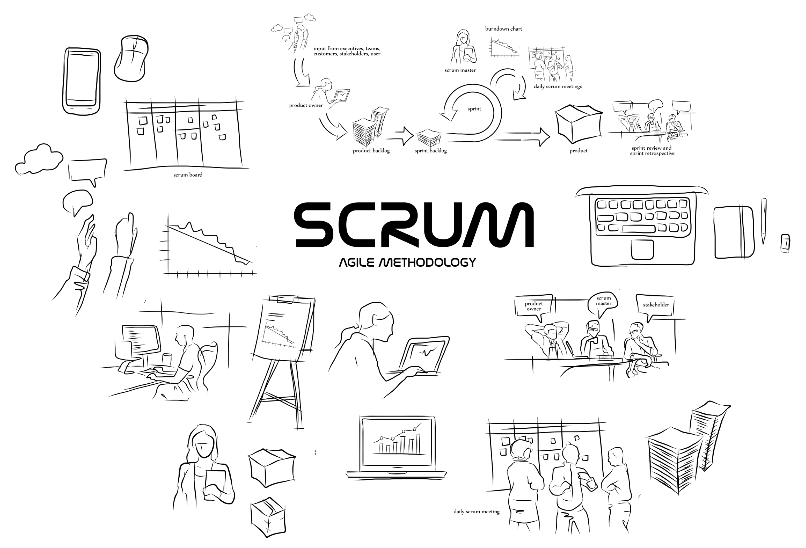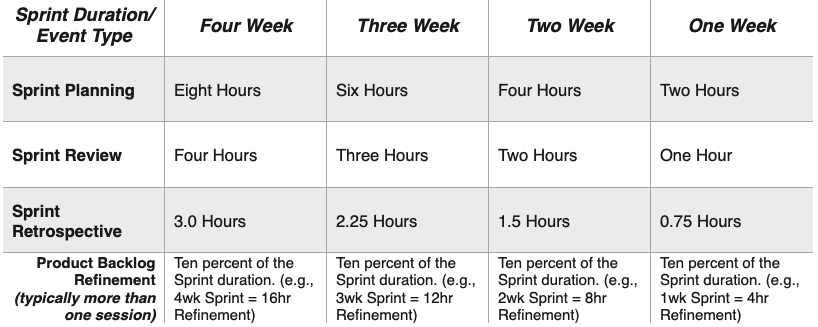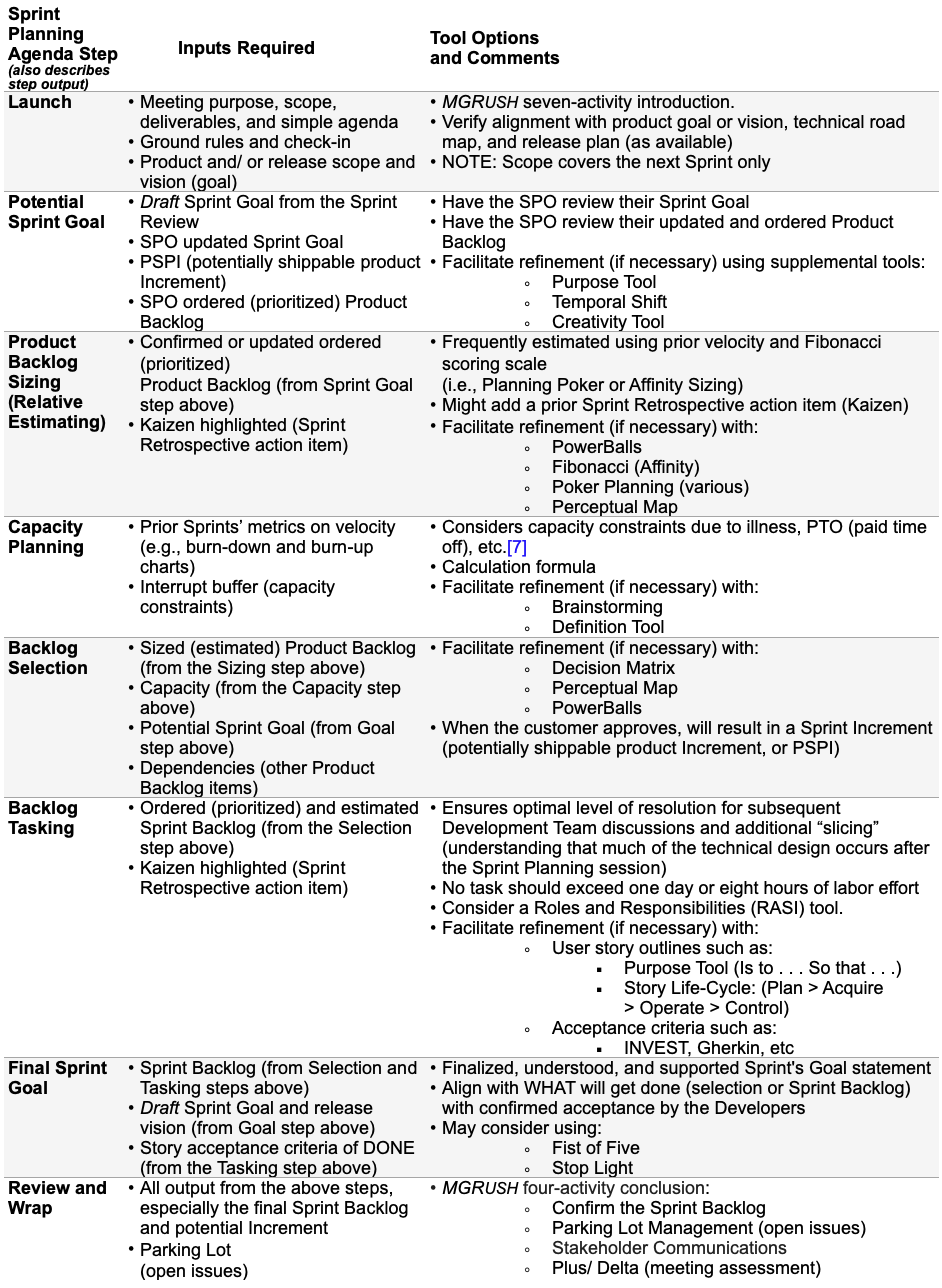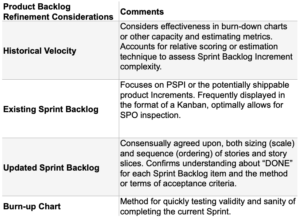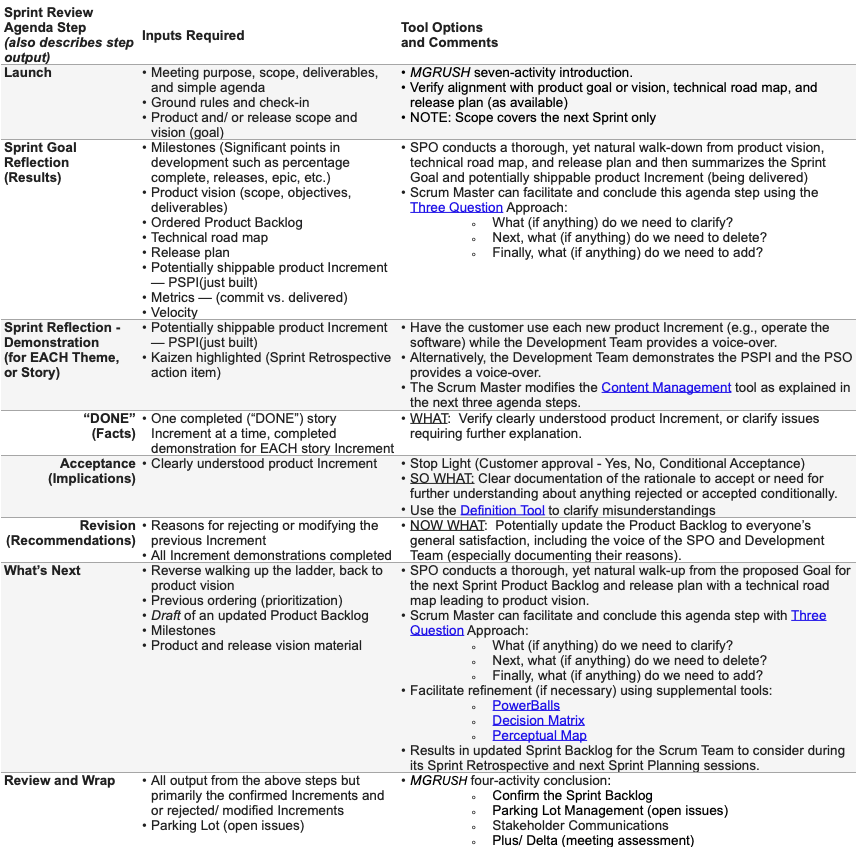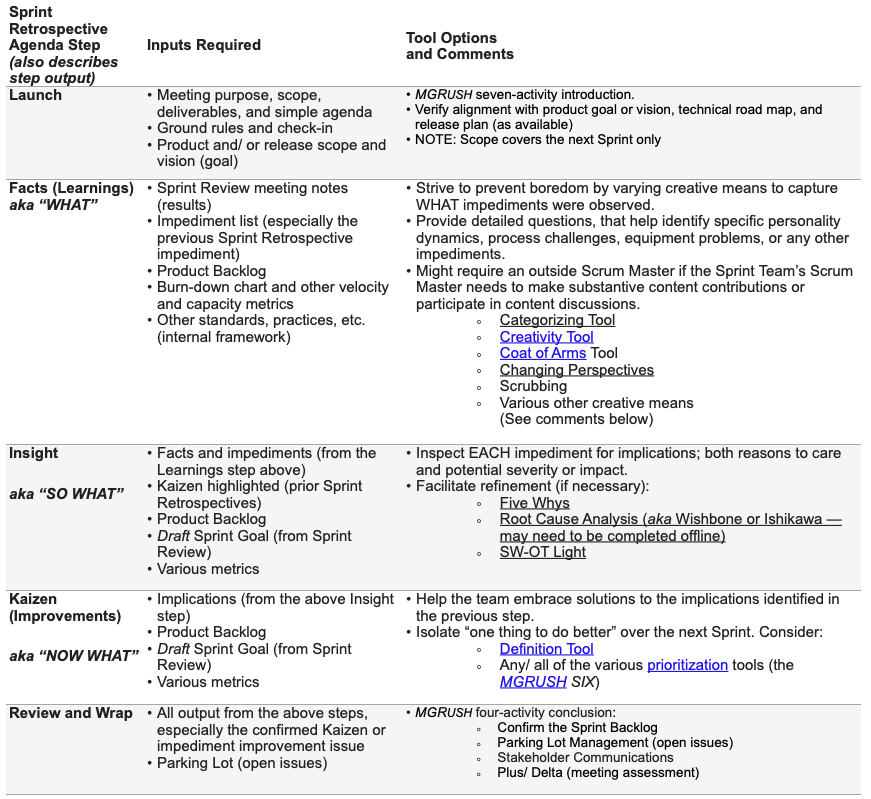The Agile mindset demands frequent, and continuing, interaction among its stakeholders. Perhaps more so with Scrum, than other frameworks. From Daily Scrum activities to Sprint Retrospective events held every one to four weeks, Scrum facilitation yields an unspeakable value for Sprints. First, an update from its creators.
Scrum Guide Update, November 2020
Definition Enhancements Including Reference to Lean Thinking
Scrum is a lightweight framework that helps people, teams and organizations generate value through adaptive solutions for complex problems.
The Scrum framework is purposefully incomplete, only defining the parts required to implement Scrum theory. Scrum is built upon the collective intelligence of the people using it. Rather than provide people with detailed instructions, the rules of Scrum guide their relationships and interactions…Various processes, techniques, and methods can be employed within the framework.
Scrum is founded on empiricism and lean thinking. Empiricism asserts that knowledge comes from experience and making decisions based on what is observed. Lean thinking reduces waste and focuses on the essentials.
Changing “Roles” to “Accountabilities”
The entire Scrum Team is accountable for creating a valuable, useful Increment every Sprint. Scrum defines three specific accountabilities within the Scrum Team: the Developers, the Product Owner, and the Scrum Master.
Changing “Development Team” to “Developers”
The specific skills needed by the Developers are often broad and will vary with the domain of work.
Changing “self-organizing” to “self-managing”
Scrum Teams are cross-functional, meaning the members have all the skills necessary to create value for each Sprint. They are also self-managing, meaning they internally decide who does what, when, and how.
Additionally
WHY was added to Sprint Planning, the three questions have been removed from the Daily Scrum (and replaced with an “actionable plan”), and they changed the term “shippable” to “useable. Artifacts now stress commitments and the phrase “product goal” now equates to the product backlog.
Scrum Facilitation Framework
Unlike waterfall mindsets, Scrum Development Teams stick together for a while. Theoretically, if forever, they may be called tribes who never disband. As teams transition from product to product, each containing multiple Sprints, new stakeholders may appear. While the Scrum Product Owner® (SPO) remains largely responsible for the relationship between the stakeholders and the Scrum Development Team, the SPO also encourages direct communications, rather than isolating or protecting either group.
Interviewing and asking questions drive the ordering of product features. Therefore, the SPO remains vigilant about developing optimal questions, sequencing them, and listening to responses. Some of the product features contained within an Ordered Product Backlog[1] derive from interviews, rather than formal Scrum facilitation events, meetings, or ceremonies.
When You Facilitate Scrum Events — Here Are The Core Scrum Facilitation Skills
Facilitative skills fortify the Scrum Master® and SPO including:
- Active Listening (i.e., understanding the WHY behind the WHAT)
- Challenging
- Preparing
- Questioning
- Remaining neutral
- Speaking clearly
Likewise, the entire Scrum Team (including the Scrum Product Owner, Scrum Master, and Scrum Development Team), operates more independently when using core facilitation skills. Arguably, we all remain more effective in embracing a servant-leader approach, even in our private lives.
How to Facilitate Scrum Events and Activities Requiring Scrum Facilitation[2]
Scrum Facilitation — Sprint Null[3]
Product Release
The launch of the Scrum team is typically driven when building a new product (software, hardware, or service). Throughout the following, as the words Product Backlog are used, they could refer to an intangible product or service. (Additionally, when certain words are capitalized, it’s because they are capitalized in the Scrum Guide or because they refer to an MGRUSH tool.)
Some refer to a product release project as an epic, a big chunk of work. An epic breaks into multiple themes, or features. Each theme or feature constitutes requirements or stories. Detailed story ‘slices’ may be called user stories or requirements.
The Scrum Guide does not use the terms ‘epic,’ ‘theme,’ ‘feature,’ or ‘story,’ and we strive to avoid relying on these terms as well. Since Mike Cohn, Kenneth Rubin, and others have used these or similar terms, we rely on you to adapt the Scrum framework and our ‘plain vanilla’ facilitation to guide you.
To launch into a series of Sprints, we need to establish the product vision (or goal) and some of the objectives and reasons for justifying investment. The product vision establishes a baseline for moving forward.
Project charters could resemble anything from over thirty pages to a Six Sigma® charter that fits on a single page. We remain methodologically agnostic but suggest that all frameworks have one thing in common, a statement of purpose.
Purpose of the Organization
First, we need to understand the reason for the existence of the sponsoring group, the customer, or the primary stakeholder. While components like mission, values, measures, etc., may be found, you can also substitute our Purpose Tool to build a quick and consensual understanding of the general intent of the organization driving the product.
Purpose of the Product
Next, at a minimum, we need to establish the purpose of the product (frequently referred to as a project). Again, while teams may build an opportunity statement, situation analysis, etc., we can roll up the primary reasons for any product with the Purpose Tool.
In addition to frequent one-on-one and one-on-few sessions, along with ongoing Backlog Refinement, the Scrum framework requires four formal Scrum events for inspection and adaptation during each Sprint. They include:
- Sprint Planning
- Daily Scrum
-
-
Development work (including Product Backlog Refinement) technically an activity, not an event—typically more than one Refinement activity per Sprint
-
- Sprint Review
- Sprint Retrospective
As a coach, impediment remover, and generally serving as a neutral party, the Scrum Master remains well suited for facilitating Sprint Planning and Sprint Reviews. Occasionally, an outside Scrum Master facilitates the Sprint Retrospective so that the participating Scrum Master may contribute as a participant.
Suggested Scrum Event Durations per Sprint (maximum)
Based on a maximum four-week Sprint, the table shows the maximum allocated time for each Scrum facilitation event or activity:
A Scrum Master should project up to eight hours of Scrum facilitation per week. Allowing a standard ratio of 2:1 for thorough preparation, a Scrum Master could be directly involved in Scrum facilitation sixty percent of their time.
While many Scrum Certification programs explain the event details, few provide extra training on the facilitation skills required. While many, if not most, of our blogs provide insight into the servant skills of facilitators, our online and in-person training yields greater insight. Next, you will find helpful Scrum facilitation event agendas, inputs required, and comments about the facilitation challenges required to lead them effectively.
Scrum Facilitation — SPRINT PLANNING
Purpose
The entire Scrum Team conducts Sprint Planning to determine WHAT can get done over the next Sprint and HOW they will do it (high-level). Strictly time-boxed to eight hours duration for a four-week sprint and sized down according to the length of shorter sprints. The purpose is to identify WHAT will get done over the next Sprint and an approximation of HOW (high-level tasking) it will be completed. Specifically, Sprint Planning answers:
- What Increments can be delivered during the upcoming Sprint?
- How will the work be completed?
Required Inputs
- Product Backlog items (ordered by SPO)[4]
- Pre-identified potentially shippable product Increment (PSPI)[5]
- Development Team capacity (during the Sprint)
- Metrics, especially velocity
- Identified Sprint Retrospective action (Kaizen)
- Draft of Sprint goal from prior Sprint Review and current Sprint goal of the SPO
Deliverable
The Sprint Goal and the Sprint Backlog that upon customer acceptance will yield the Sprint Increment, updated Product Backlog with Kaizen. Optionally, an updated Product Vision and Scope.
Sprint Planning Agenda and How to Facilitate[6]
Scrum Facilitation — PRINCIPLES OF A DAILY SCRUM
Purpose
There are good meetings and there are long meetings but there are not many good, long meetings. The Scrum framework encourages the Developers to conduct a Daily Scrum (frequently a stand-up meeting). Other stakeholders (in addition to the Scrum Master, Product Owner, and Developers), may observe and occasionally, the Scrum Master may be invited in as a facilitator.
Strictly time-boxed to fifteen minutes duration, the Daily Scrum may also be referred to as a roll call (usually morning) or a daily huddle. To amplify team cadence, conduct the Daily Scrum in the same place and time every day.
The purpose allows for inspection and adaptation that helps synchronize the Developer’s plan and activities over the next 24 hours as well as identify impediments for which the team requires outside support.
“Every day, the Developers should understand how it intends to work together as a self-organizing team to accomplish the Sprint Goal and create the anticipated Increment by the end of the Sprint.”
Required Inputs
- Sprint Goal
- Sprint Backlog
- Burn-down chart
- Impediment list
Three Questions Was Changed with Scrum Guide 2000
Because Kanban boards display what has been completed, the 3-questions approach has been modified to focus on impediments or blockers that may be getting in the way
“The Scrum Master ensures that the Developers have the meeting, but the Developers are responsible for conducting the Daily Scrum. The Scrum Master teaches the Developers to keep the Daily Scrum within the 15-minute time-box. The Daily Scrum is an internal meeting for the Developers. If others are present, the Scrum Master ensures that they do not disrupt the meeting.”
Pre-2020 Three-Question Approach
Approximating the format of yesterday, today, and tomorrow, modify three questions to meet your needs:
1. What did I do yesterday that helped the Development Team meet the Sprint Goal? (or, What did I accomplish yesterday)?
2. Next, what will I do today to help the Development Team meet the Sprint Goal? (or, What will I accomplish today)?
3. Finally, what impediments prevent me or the Development Team from meeting the Sprint Goal? (or, What obstacles are impeding my ability to get done)?
Motivational Version
1. What did you do to change the world yesterday?
(or, What did you accomplish since the last Daily Scrum)?
2. How are you going to crush it today?
(or, What are you working on until the next Daily Scrum)?
3. How you are going to blast through any obstacles unfortunate enough to be standing in your way?
(or, What’s getting in your way, keeping you from doing your job)?
Outputs
- Socialized plans over the next 24 hours
- Impediments and blockers identified
Comments
Standing, rather than sitting, ensures that meetings remain brief and discourages wasted time.
The Daily Scrum does not provide the time and place to solve problems. Rather, the Daily Scrum makes the team aware of its current status. If further discussion is needed, a longer meeting with appropriate parties can be arranged or conducted after the Daily Scrum with only the necessary participants. Topics that require additional discussion should always be deferred until every team member has reported.
Remember to have members focus on WHAT they are doing. Discussions about WHY they are doing it should be deferred to a planning meeting. Discussions about HOW they are doing it should be deferred to a design meeting or technical discussion.
Take an MGRUSH Certified Structured Facilitation class to learn WHAT the difference is and HOW to explain it.
Scrum Facilitation — PRODUCT BACKLOG REFINEMENT(S)
Purpose
Product Backlog refinement occurs as necessary and fortifies the product Increment expected over the concurrent Sprint. The Scrum Development Team meets independently. Others may observe or be invited for input. The Scrum Master stands alert to help remove identified impediments. On occasion, they may be asked to facilitate.
Deliverable
Updated Sprint Backlog and story tasking, along with potential impediments to be noted.
Considerations

Kanban Supports Scrum Events
Scrum Facilitation — SPRINT REVIEW
Purpose
The Sprint Review provides an inspection and adaptation checkpoint for the potentially shippable product Increment built over the prior Sprint and includes the Scrum Team and stakeholders. Because stakeholders attend, consider a dry-run rehearsal before the formal session begins. Strictly time-boxed to four hours duration for a four-week sprint and sized down according to the length of shorter sprints.
Required Inputs
Some of the information that should be brought in or visually displayed include:
- Potentially shippable product Increments (PSPI)
- Ordered Sprint Product Backlog
- Metrics such as Velocity and Burn Down chart
- Sprint Goal
- Release plan including product and/ or release scope and vision (goal) and technical road map (as applicable)
Deliverable
An updated Product Backlog (and optionally updated Product scope and vision).
How to Facilitate
The next table shows you HOW TO facilitate a Sprint Review. There is more than one right answer and more than one right tool per step.
However, there is a wrong answer too. That is if you don’t know how you are going to facilitate the session before it begins. Make sure as the session leader, you know what “DONE” looks like.
Scrum Team Tools
Some other tools that a Scrum Team might consider based on the suggestions and experience of the Scrum Master include:
- Categorizing (for naming new themes or stories; i.e., Increments)
- Context Diagram (for improved scope understanding)
- Framing (faster alternative to Context Diagram for scoping)
- Guardian of Change (for critical or complex communications plan)
- Prioritization Tools (the MGRUSH SIX)
- Purpose Tool (for slicing epics, themes, or large stories and product Increments)
- Requirements Gathering (to improve Increment or story resolution and more detail on what “DONE” looks like)
- Splitting Stories (Plan > Acquire > Operate > Control)
- SW-OT Lite (for complex prioritization)
- User Story and Acceptance Criteria (various forms or templates)
- Temporal Shift (to improve consensual understanding of Goals)
Scrum Facilitation — SPRINT RETROSPECTIVE
Purpose
Here the Scrum Team inspects and adapts to impediments around the team’s efforts and results over the prior Sprint. Also, planning robust Sprint Retrospective activities helps the team get better while preventing boredom. Strictly time-boxed to three hours duration for a four-week sprint and sized downward according to the length of shorter sprints.
Arguably the most important meeting of all, intended to ensure continuous improvement, experts recommend three hours of preparation for a ninety-minute Sprint Retrospective.
Required Inputs
- Last Sprint Retrospective action
- Metrics (especially burn-up and burn-down velocities)
- Definition of DONE (for each Increment or theme)
- Process standards and practices (i.e., internal framework)
- Impediment list
Deliverable
An improvement plan with an identified focus on one action to improve over the next Sprint (Kaizen).
How to Facilitate
The next table shows you HOW TO facilitate a Sprint Retrospective. Keep in mind there is more than one right answer and more than one right tool per step.
However, there is a wrong answer too. That is if you don’t know how you are going to facilitate the session before it begins. Make sure as the session leader, you know what “DONE” looks like.
Other Creative Tools
- Amazon Review
- Five Why’s or Quick RCA (Root Cause Analysis)
- Lean Coffee
- Mad/ Glad/ Sad (Stop/ Start/ Continue)
- Participant Prioritization (using various tools over the life-cycle of the project)
- Post-it Note Affinity Diagram
- Remember the Future (Temporal Shift)
- Starfish
- Speedboat/ Sailboat
- Three Words
Scrum Facilitation in Conclusion
Finally, please remember that the Voting Method of prioritization does not generate higher quality decisions, only a bigger number. Consider some of the optional tools offered by MGRUSH as solid options for both prioritizing and conducting many of the activities found during your Scrum Sprint events.
______
[1] The Scrum Guide was modified in 2011 and 2020. The Product Backlog became “ordered,” instead of “prioritized,” providing flexibility to the Product Owner to optimize value in his or her unique circumstances.
[2] ©2017 Ken Schwaber and Jeff Sutherland. Offered for license under the Attribution Share-Alike license of Creative Commons, accessible at http://creativecommons.org/licenses/by-sa/4.0/legalcode and also described in summary form at http://creativecommons.org/licenses/by-sa/4.0/. By utilizing this Scrum Guide, you acknowledge and agree that you have read and agree to be bound by the terms of the Attribution Share-Alike license of Creative Commons.
[3] For empirical reasons to avoid the expression “Sprint 0 (zero)” see: Why using Sprint 0 is a cardinal sin for all Scrum Masters
[4] Depending on the level of resolution or specificity, items could be broad (epic), moderate (theme), narrow (story), or ready (story slice) …
[5] An increment is a body of inspectable, done work that supports empiricism at the end of the Sprint. The increment is a step toward a vision or goal. The increment must be in useable condition regardless of whether the Product Owner decides to release it.
[6] For a nice primer and overview of “How to Run An Agile Sprint Planning Meeting” see “How To Run A Sprint Planning Meeting Like A Boss (+ Meeting Agenda)” by Alexa Huston of the Digital Project Manager.
[7] PTO reflects Paid Time Off or other planned or surprise reasons for absences.
______
Don’t ruin your career by hosting bad meetings. Sign up for a workshop or send this to someone who should. MGRUSH workshops focus on meeting design and practice. Each person practices tools, methods, and activities daily during the week. Therefore, while some call this immersion, we call it the road to building high-value facilitation skills.
Our workshops also provide a superb way to earn up to 40 SEUs from the Scrum Alliance, 40 CDUs from IIBA, 40 Continuous Learning Points (CLPs) based on Federal Acquisition Certification Continuous Professional Learning Requirements using Training and Education activities, 40 Professional Development Units (PDUs) from SAVE International, as well as 4.0 CEUs for other professions. (See workshop and Reference Manual descriptions for details.)
Want a free 10-minute break timer? Sign up for our once-monthly newsletter HERE and receive a free timer along with four other of our favorite facilitation tools.
Go to the Facilitation Training Store to access proven, in-house resources, including fully annotated agendas, break timers, and templates. Finally, take a few seconds to buy us a cup of coffee and please SHARE with others.
In conclusion, we dare you to embrace the will, wisdom, and activities that amplify a facilitative leader. #facilitationtraining #MEETING DESIGN
______
With Bookmarks no longer a feature in WordPress, we need to append the following for your benefit and reference
- 20 Prioritization Techniques = https://foldingburritos.com/product-prioritization-techniques/
- Creativity Techniques = https://www.mycoted.com/Category:Creativity_Techniques
- Facilitation Training Calendar = https://mgrush.com/public-facilitation-training-calendar/
- Liberating Structures = http://www.liberatingstructures.com/ls-menu
- Management Methods = https://www.valuebasedmanagement.net
- Newseum = https://www.freedomforum.org/todaysfrontpages/
- People Search = https://pudding.cool/2019/05/people-map/
- Project Gutenberg = http://www.gutenberg.org/wiki/Main_Page
- Scrum Events Agendas = https://mgrush.com/blog/scrum-facilitation/
- Speed test = https://www.speedtest.net/result/8715401342
- Teleconference call = https://youtu.be/DYu_bGbZiiQ
- The Size of Space = https://neal.fun/size-of-space/
- Thiagi/ 400 ready-to-use training games = http://thiagi.net/archive/www/games.html
- Visualization methods = http://www.visual-literacy.org/periodic_table/periodic_table.html#
- Walking Gorilla = https://youtu.be/vJG698U2Mvo

Terrence Metz, president of MG RUSH Facilitation Training, was just 22-years-old and working as a Sales Engineer at Honeywell when he recognized a widespread problem—most meetings were ineffective and poorly led, wasting both time and company resources. However, he also observed meetings that worked. What set them apart? A well-prepared leader who structured the session to ensure participants contributed meaningfully and achieved clear outcomes.
Throughout his career, Metz, who earned an MBA from Kellogg (Northwestern University) experienced and also trained in various facilitation techniques. In 2004, he purchased MG RUSH where he shifted his focus toward improving established meeting designs and building a curriculum that would teach others how to lead, facilitate, and structure meetings that drive results. His expertise in training world-class facilitators led to the 2020 publication of Meetings That Get Results: A Guide to Building Better Meetings, a comprehensive resource on effectively building consensus.
Grounded in the principle that “nobody is smarter than everybody,” the book details the why, what, and how of building consensus when making decisions, planning, and solving problems. Along with a Participant’s Guide and supplemental workshops, it supports learning from foundational awareness to professional certification.
Metz’s first book, Change or Die: A Business Process Improvement Manual, tackled the challenges of process optimization. His upcoming book, Catalyst: Facilitating Innovation, focuses on meetings and workshops that don’t simply end when time runs out but conclude with actionable next steps and clear assignments—ensuring progress beyond discussions and ideas.

